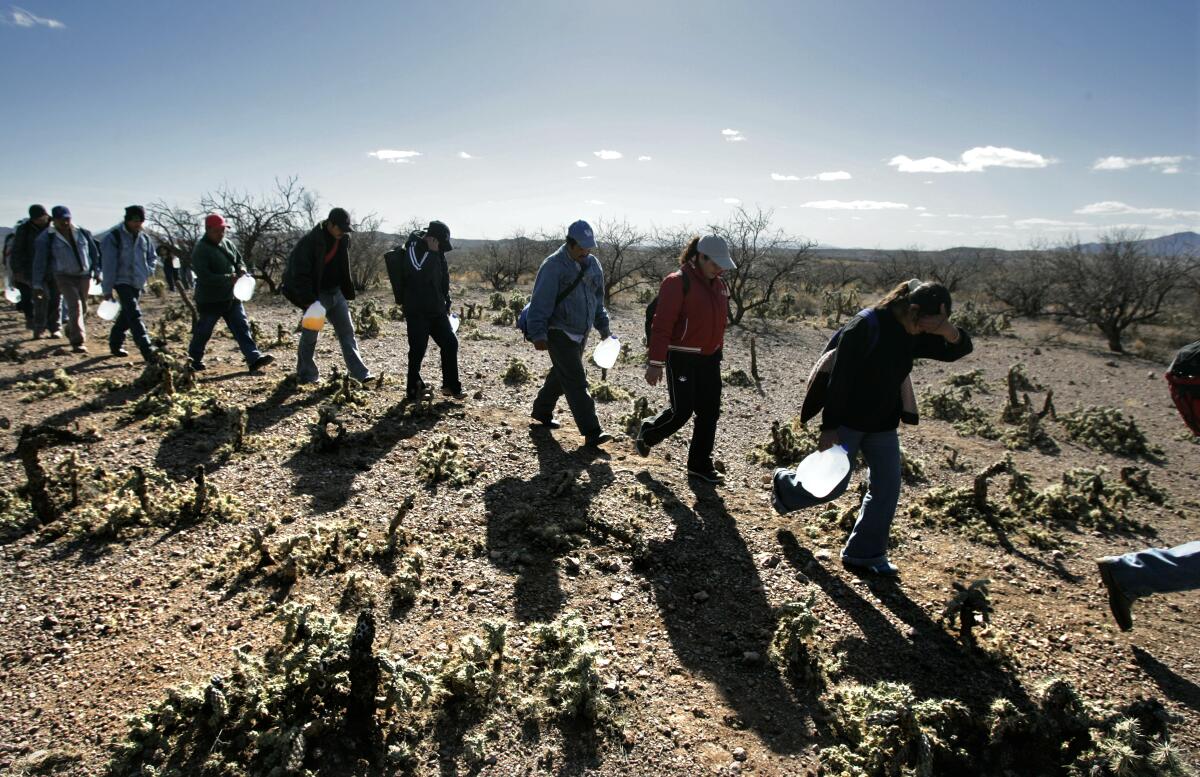Column: How the Border Patrol helped cause the ‘browning’ of America

- Share via
Pedro Loza, now 74, recalls the exact moment he realized he would have to settle in the United States, despite his dream of returning to reside once again in his beloved Mexico.
He was working in construction in Chicago in the 1990s, watching Spanish-language TV news reporting on California’s spate of anti-immigrant policies, including the notorious Proposition 187, which targeted people without papers. President Clinton had begun construction of a steel border fence in San Diego and invested in helicopters, sensors, night scopes and all-terrain vehicles for the U.S. Border Patrol.
Loza and millions of others who previously zigzagged across the border — working seasonally in the U.S, while investing in a dream house or small business in Mexico — were trapped. Having come without papers, many feared if they returned home, they might not be able to reenter the U.S. to earn the wages they needed to see their dreams through.
“We realized that if we wanted to work in the U.S., we had to immigrate,” Loza told me. “We had to live here.”
That decade, Loza applied for citizenship, and for the first time, he began to accept the U.S. as home.
The average profile of arrivals at the Southwest border has changed dramatically since then, from single adult Mexican laborers to Central American families seeking asylum. Yet a new uptick in single adult economic migrants from Mexico is driving a familiar wave of anti-immigrant hysteria.
A recent Breitbart article — “Report: ‘Mostly’ Single Male Border Crossers Bussed to Louisiana Cities” — inspired comments such as “Their job is to vote communist democrat and rape women” and “They are REPLACING YOU, Louisiana.”
Now for the irony: The people who are so concerned about brown men entering this country are arguably the most responsible for the recent demographic shifts.
Most Mexicans who came before border militarization never planned to stay — only to work. The U.S. offered great pay but it felt foreign, with its English language and colder culture. Loza, for example, wanted to save to buy a tractor in Guanajuato, where he sent money to family and even purchased a cattle ranch. “My dream was always to return to Mexico,” he told me.
His daughter, Mireya Loza, is an associate professor of history at Georgetown University and author of “Defiant Braceros,” about the 1942-1964 “bracero” program for temporary migrant workers to fill wartime labor shortages. After employer abuses came to light and the program was abolished by Congress, many continued to cross the border for the same seasonal work. But now, they crossed illegally, stepping over trampled, paltry barbed wire in San Diego and elsewhere.
In the 1990s, California politicians cast those workers as criminals to pander to white racial anxiety. The resulting hysteria and enforcement closed off reverse migration.
Is it time for a new bracero program? Mexico President Andrés Manuel López Obrador proposed one. Currently, visas for temporary agricultural laborers, known as H-2As, are uncapped. López Obrador’s plan would increase the legal pipeline of nonagricultural guest laborers to the U.S. But Mireya Loza isn’t sold. Guest worker visas, she maintains, often mean deplorable working conditions and low wages. She argues for greater green card access instead, enabling people to “exercise their labor and civil rights.”
This year, U.S. Customs and Border Protection has encountered more than 441,000 single adult Mexicans at the Southwest border, up 72% from last year. These people are coming to harvest our food, build our homes and heal our post-pandemic economy. Whining about them displacing white people will cut off this labor and trap those who are here, just as U.S. policies did in the ’90s.
For many Mexicans, the dream was never about living in the U.S. Rather, the sueño is about returning to live large in Mexico with hard-earned U.S. dollars. The popular misconception that all migrants want to stay here is rooted in the myth of U.S. exceptionalism.
I hate to break it to the believers, but many Mexicans have no interest in the American dream. What they’re chasing is the return-to-Mexico dream.
Gil Kerlikowske, former U.S. Customs and Border Protection commissioner, recalls that before the Secure Fence Act of 2006, many single adult migrants crisscrossed the border. “People would come in to work during the day or during the week,” he told me. “And then, because enforcement and security wasn’t that strong, they’d return back to Mexico.”
Today’s Border Patrol is unrecognizable from the agency of earlier years. Since 1986, the number of officers ballooned from 2,000 to 20,000, and its budget from $200 million to $5 billion. During that period, the undocumented population swelled, from around 2 million to 11 million. Border militarization did not work to prevent migration — but it closed the path home.
Douglas Massey, a Princeton University sociology professor, has studied for decades how border militarization backfires on racist politicians. “They’re the ones who cut off the return flow of immigrants,” he told me.
The way to discourage economic migrants from contributing to the dreaded “browning” of America — for those who fret about such things — is to allow freer movement across the Americas, as between the U.S. and Canada.
As long as the U.S. allows the free movement of weapons and cash, and not humans, many will be forced to make a one-way trip here. If that’s what nativists want, pouring billions into more border walls and enforcement is a perfect strategy. Carry on.
More to Read
A cure for the common opinion
Get thought-provoking perspectives with our weekly newsletter.
You may occasionally receive promotional content from the Los Angeles Times.












